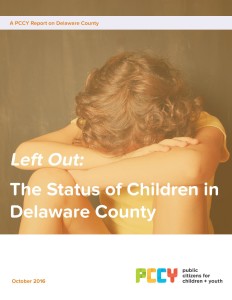Children Still in Recession in Delaware County Despite Recovery
El aumento de la pobreza infantil y el menor rendimiento de los estudiantes ensombrecen los modestos logros
 Philadelphia (Oct 13, 2016) – While recent headlines tout a national recovery from the Great Recession, more children in Delaware County are facing hardships than during the depths of the recession, a new study has found.
Philadelphia (Oct 13, 2016) – While recent headlines tout a national recovery from the Great Recession, more children in Delaware County are facing hardships than during the depths of the recession, a new study has found.
Ciudadanos públicos para la infancia y la juventud [PCCY] anunció nuevas informes completos on the status of children in Delaware, Montgomery, Bucks and Chester counties, entitled, “Left Out.” The Delaware County report, the first of the series, was released today.
“An American tragedy is happening right before our eyes, yet it’s very hard to see. The headline news touts a strong economic recovery, and monthly jobs reports amplify that message. But PCCY dug into the data and in Delaware County found a very different and alarming story that does not bode well for children or the county,” said Donna Cooper, Executive Director of Public Citizens for Children and Youth.
The new PCCY “Left Out” series unveils a Child Wellness Index that measures if children are worse off or better with respect four domains: K-12 education, early childhood education, health and economic well-being. Compared to 2008 when the recession was just beginning, in two Child Wellness Index domains – economic well-being and K-12 education – children in Delaware County are faring worse. For early childhood education their situation has not improved, while their health status has improved considerably.
“It’s pretty startling that in nine of the 16 Index measures, children were faring worse in Delaware County compared to 2008. Even where children are doing better, thousands of children are up against very bad odds,” said Cooper.
El repunte económico aún no llega a los niños
“More and more of our students in the William Penn School District are eligible for free and reduced price school meals, in spite of the economic recovery. In 2008, one out of two students were eligible; today it’s three out of four students.” – Rafi Cave, Vice President of the William Penn School Board
- Among the four suburban Philadelphia counties, five years after the recession (2015), Delaware County had the highest child poverty rate compared to the other counties at 14.1%, or 17,388 children, still higher than the 12.8% at the start of the recession. To put that number in perspective, the number of children in poverty in Delaware County would fill up nearly every seat in the Wells Fargo Center for an NHL Hockey game.
- Among the children in poverty, slightly more than 7,600 are living in families earning less than half of the poverty level ($10,000 or less per year for a family of three). That’s 2,000 more children than the total number enrolled in the Haverford Township School District.
La mayoría de los distritos escolares tienen menos fondos incluso con más estudiantes que necesitan ayuda adicional
“Delaware County is a poster child for school funding inequities. You can drive twelve miles down the Blue Route from Radnor, one of the wealthiest school districts in the state, to Chester-Upland, one of the poorest. Our concern and responsibility for kids must not end at our school district’s borders.” – Lawrence Feinberg, Haverford Township School Board member
- By 2014, 41% of the public school students in the county were from low income families. The districts hardest hit by the elimination of Stimulus state and federal aid in FY 2011 were those districts with the largest share of low income student; they had on average $10,000 less per classroom available for instruction in FY 2014, even after factoring in local tax increases in every district.
- As a result, student performance declined. More than 9,800 public school students in the county could not pass state reading assessments in 2014, a full 30.5% of all students in the county. This fail rate is one point higher than in 2008. The pass rate for math declined even faster than reading from 2008-2014, pushing the fail rate to 28.2%
Mejoró el acceso a experiencias de aprendizaje temprano de calidad, pero la mayoría de los niños pobres aún no reciben este comienzo inteligente
“The whole county stands to benefit from reducing the significant education disparities among children. Half the achievement gap exists before children start kindergarten. While the DCIU takes great pride in the high quality early childhood education programs we currently provide, the report highlights the significant work that needs to be done in the region to improve quality in the early childhood sector so that every child can live up to her or his potential.” – Maria Edelberg, Executive Director of the Delaware County Intermediate Unit
- Young families are struggling with the rising costs of child care in Delaware County, where 3 out of 4 children under six years old have all parents in the workforce. Full-time childcare for two children (a preschooler and an infant) totaled $21,190, or a third of the county’s median household income.
- More children in publicly subsidized child care were in high quality programs in 2014 compared to 2008, but still 80% cannot get access to those programs due to shortages in public funds. Meanwhile fewer children were able to enroll in publicly funded pre-k, with three out of four eligible children in the county unable to enroll in high quality pre-k due to lack of public funding.
El estado de salud de los niños logró los mayores avances, pero los niños más pobres muestran signos reales de problemas
“Because of racial disparities in birth outcomes in Delaware county, we are using data to inform a collective impact approach to plan and develop strategies to close the gap to help ensure every child in our county has a healthy start.” – Joanne Craig, Administrative Director of Crozer-Keystone Women and Children’s Health Services
- The strongest public policy that protected children during the recession was the availability of state and federally subsidized health care coverage for children. In spite of job losses and cuts to employee benefit packages during the recession, the share of children insured rose nearly two points from 2008 to 2014 to 96% thanks to CHIP and Medicaid. Still, approximately 5,000 children are uninsured, and many of them don’t have the option to enroll in publicly subsidized programs because of the state’s ban on undocumented children’s access to such health care supports.
- Racial health disparities are becoming more dramatic. The county’s infant mortality rate rose from 7.4 deaths per 1,000 births to 9.6 deaths; the rate for both white and black babies increased, but the rate of death for black births was three times higher than the rate for white births. In 2015, 11% of children did not see a dentist; here again racial disparities are evident, with just 5.6% of white children foregoing dental care annually compared to 22% of Latino and 25% of black children.
La política pública ayudó a reducir la pobreza de las personas mayores, pero no lo hizo para los niños
- En todos los condados, la recesión económica afectó a miles de niños y adultos mayores, aumentando el número de personas en situación de pobreza en su punto más bajo. Pero a diferencia de las personas mayores, donde las políticas públicas efectivas les ayudaron a recuperarse más rápidamente en todos los condados suburbanos, los niños no recibieron las mismas protecciones. Estas políticas incluyen Medicare, Seguro Social, Cobertura de Medicamentos Recetados del Estado de Pensilvania (PACE), Reembolso de Rentas y Impuestos a la Propiedad de Pensilvania y políticas de impuestos estatales que excluyen las ganancias de jubilación de los impuestos estatales.
- From 2008 to 2015, the child poverty rate has been 7.5% higher on average than the senior poverty rate in Delaware County. In 2013, the senior poverty rate began to decline, a full year earlier than the child poverty rate.
“Estos informes muestran que las buenas políticas públicas son muy eficaces para cambiar los resultados de la vida de los niños; en muchos casos, son las únicas herramientas que marcan la diferencia”. dijo Cooper. “Elected officials and their constituents have the opportunity to build the public will to adopt policies that protect children and strengthen the prospects of Delaware County.”
Recomendaciones de política
- Boost Job Longevity and Pay: Increase the minimum wage and implement workforce supports including predictable scheduling and paid sick and family leave.
- Aumentar los ingresos del hogar: Conecte a las familias con los ingresos federales y apoyos laborales como el Crédito Tributario por Ingreso del Trabajo, el Crédito Tributario por Hijos y SNAP.
- Alimente a los niños hambrientos: Ampliar la participación en el programa de comidas escolares.
- Garantizar el acceso a la atención médica: Ampliar el seguro médico público para los niños indocumentados.
- Reducir la mortalidad infantil: Asegurar que los proveedores de Medicaid y CHIP implementen estrategias para impulsar la utilización de la atención prenatal y posnatal entre las mujeres negras.
- Elimine el envenenamiento infantil con plomo: Asegurar que los proveedores de salud financiados con fondos públicos realicen pruebas a todos los niños menores de tres años; remediar los hogares de mujeres embarazadas con alto riesgo de peligros relacionados con el plomo.
- Increase School Attendance: Improve how public health providers address asthma, including home visits to reduce home-based asthma triggers.
- Reduzca aún más la tasa de embarazo adolescente: Aumentar el acceso a métodos anticonceptivos de acción prolongada para adolescentes con Medicaid.
- Amplíe el alcance de la intervención temprana: Ampliar el uso de herramientas de detección temprana para identificar a todos los niños que necesitan servicios de intervención temprana.
- Haga que el cuidado infantil de calidad sea asequible: Utilice los recursos del estado y del condado para incentivar a los proveedores a mejorar la calidad y permitir que los proveedores que ya son de alta calidad se expandan.
- Expand Pre-K: Increase state investment in pre-k to create a seat for every eligible child.
- Aumente el acceso al jardín de infantes de día completo: Eliminar las barreras financieras que limitan la capacidad de los distritos escolares para ofrecer kindergarten de día completo.
- Abordar la crisis de financiación escolar: Aumentar los fondos estatales para las escuelas públicas y distribuir esos fondos a través de la Fórmula de financiación de la educación básica.
Enlaces y gráficos
See the full Delaware County report at: https://www.childrenfirstpa.org/wp-content/uploads/2016/10/Left-Out_Delaware-County.pdf
See and share Delaware County indicator graphics at: https://www.childrenfirstpa.org/resource/left-delaware-county-indicators/
Vea los informes de los cinco condados en: https://www.childrenfirstpa.org/report/left-regional-reports-child-well/
